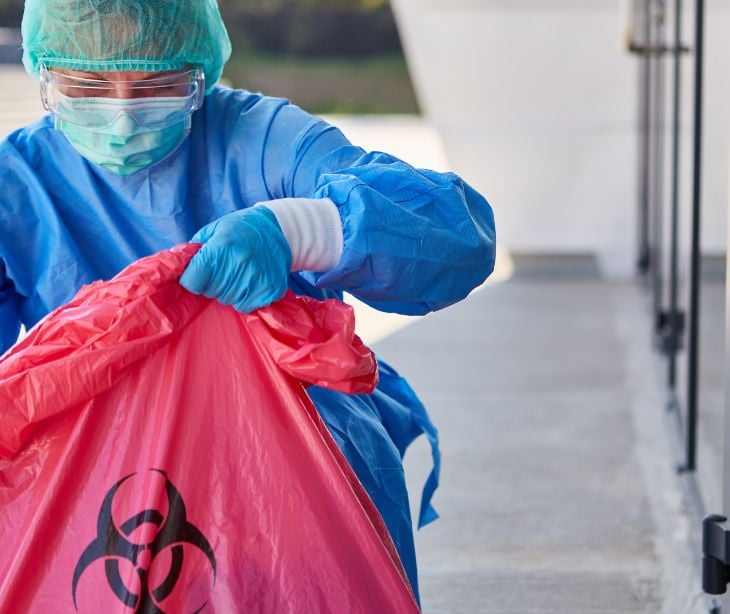
In healthcare workplaces, various hazards can pose risks to the well-being of healthcare workers, patients, and anyone else in the workspace. From chemical and drug exposure to sharps injuries, healthcare workers face multiple potential exposures that require careful management and prevention strategies.
What is the Occupational Safety and Health Act?
The Occupational Safety and Health Act (OSH Act) ensures the safety and well-being of workers across various industries and workplaces. The OSH Act sets forth a "general duty clause" requiring employers to provide a hazard-free working environment that does not pose any recognized threats of serious harm or death to employees. It created the Occupational Safety and Health Administration (OSHA), a federal agency responsible for enforcing its provisions.
OSHA and hazards
One important aspect of OSHA's regulatory framework is the hazard communication standard. This standard aims to promote chemical safety in the workplace by requiring employers to provide written information about the identities and hazards associated with chemicals used in the workplace. This information should be easily accessible to employees and presented in a clear and understandable manner.
Identifying hazards in healthcare
One of the main hazards that healthcare workers often face is chemical and drug exposure. This can occur through the handling and administration of medications, exposure to hazardous chemicals used in cleaning and disinfection processes, and contact with hazardous substances such as chemotherapy drugs. Another hazard is sharps injuries, which can result from accidental needlesticks or other sharp object injuries that may expose healthcare workers to bloodborne pathogens.
However, these hazards are just two examples among a variety of potential exposures in healthcare workplaces. Other hazards can include physical emergencies such as slips, trips, and falls, as well as biological emergencies like infectious disease outbreaks. Healthcare workers may also be at risk of laser hazards and anesthetic gas exposures. Healthcare organizations need to be aware of these hazards and implement measures to mitigate the risks they pose.
Related: How HIPAA and OSHA work together
Hazard prevention
To prevent hazards in healthcare workplaces, a multifaceted approach is required. Compliance with OSHA regulations and guidelines is necessary, and healthcare organizations should ensure that their compliance officers and safety managers implement the proper training to mitigate risks. Additionally, safety protocols should be established, and risk assessments should be conducted to identify potential hazards. Utilizing safety data sheets (SDS) when needed and implementing risk-based engineering controls are also important prevention tactics.
OSHA requirements and the hazard communication standard
OSHA regulates health and safety within workplaces, including healthcare settings. When it comes to hazard prevention, OSHA outlines five primary elements that healthcare organizations should consider:
- Workplace safety plan development and sustainability: Healthcare organizations should develop and maintain a safety plan that addresses potential hazards and outlines procedures for mitigating risks.
- Organizational participation in hazard prevention and safety planning: It is important to promote organizational participation in identifying and addressing hazards. This can involve engaging employees in safety committees, conducting hazard assessments, and actively involving staff in safety planning.
- Use of personal protective equipment (PPE) and monitoring effectiveness: Healthcare organizations should provide appropriate PPE to employees and regularly monitor its effectiveness. This includes ensuring that employees receive proper training on the use of PPE and conducting periodic assessments to evaluate its adequacy.
- Continued upkeep and acceptance of safety practices and protocols: Safety practices and protocols should be regularly reviewed and updated to reflect the latest standards and best practices. Employees should be educated and trained on these practices, and their compliance with safety protocols should be monitored and reinforced.
- Continued training plan distribution: Healthcare organizations should have a plan in place for distributing and documenting ongoing training for employees. This ensures that employees receive relevant education and updates on safety practices and procedures.
See also: HIPAA Compliant Email: The Definitive Guide
In the news
An investigation by the Occupational Safety and Health Administration (OSHA) revealed severe workplace violence at Wekiva Springs Hospital in Jacksonville. Workers endured assaults, confinement by patients, and injuries including broken bones, concussions, and wounds from scratching, biting, punching, and kicking.
OSHA found that in 2022 alone, there were 182 alleged incidents, with nearly 70% requiring police response. The facility failed to protect staff from recognized hazards, resulting in a citation for a serious violation and proposed penalties of $15,625.
FAQs
What are the general OSHA standards for healthcare?
The General Duty Clause of the OSH Act requires employers to provide workers with a safe workplace that does not have any known hazards that cause or are likely to cause death or serious injury.
If my workplace is unsafe, what can I do?
If you believe working conditions are unsafe or unhealthy, you can bring the conditions to your employer's attention, contact your local OSHA Office, or file a safety and health complaint.
Why is workplace safety important in healthcare?
Workplace safety is important in healthcare to protect the well-being of healthcare workers, patients, and anyone else in the workspace. By ensuring a safe work environment, healthcare organizations can minimize the risks associated with hazards and promote the overall health and safety of their employees and patients.
Subscribe to Paubox Weekly
Every Friday we'll bring you the most important news from Paubox. Our aim is to make you smarter, faster.




